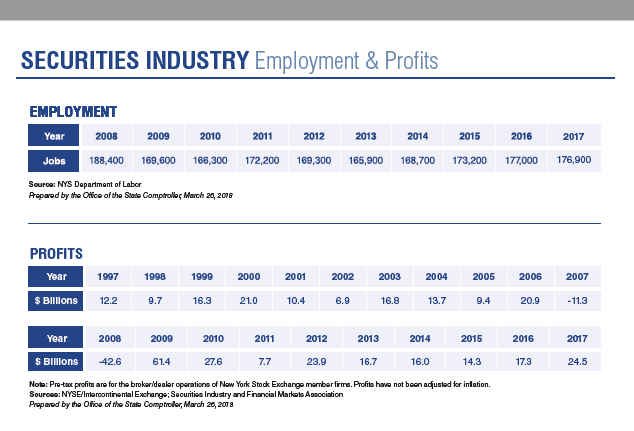Wall Street is both shrinking and growing at the same time. A report from New York Comptroller Thomas DiNapoli illustrates how financial success does not always translate into employment growth in an era where technology is just starting to emerge to challenge humans for jobs.

Wall Street is getting richer but reducing headcount at the same time.
Pretax profits on the broker/dealer operations of New York Stock Exchange member firms, a traditional if a limited measure of “Wall Street” profits, jumped by 42% in 2017 to $24.5 billion. The profit surge, the largest since 2010, came after profits rose 21% in 2016 and came at a time when regulations were being reduced, and a quantitatively driven bull market raged.
Big Fund Managers Could Get Bigger Amid Continued Changes
“The large increase in profitability over the past two years demonstrates that the industry can prosper with the regulations and consumer protections adopted after the financial crisis,” DiNapoli said in a statement.


When brokerage profits jumped so did bonus pools, but not to the same degree. The average bonus paid to financial service industry employees in New York City climbed 17% to hit $184,220, less than half the jump in profits.
The average salary with bonus was $375,200 in 2016, five times higher than in the rest of the private sector, which averaged $74,800. This occurred as 23% of the industry’s employees in the city earned more than $250,000, while only 2% of the balance of the city’s workforce pay climbed above that level. Meanwhile, the total median wage for the average worker nationwide in the fourth quarter was $44,564, according to the Bureau of Labor Statistics.
Strong revenue growth occurred in wealth management fees, underwriting and other income related to securities business, which includes fees from advising on mergers and acquisitions. While the investment advisors made money, those involved in trading didn’t have as good a year on a relative basis. DiNapoli noted trading revenue, which accounted for 8% of net income in 2017, fell sharply as the year progressed but was still up 10% for all of 2017.
The growth in the bonus pool was enhanced by changes in the federal tax code that eliminates the corporate deduction for performance-based pay beginning in 2018, encouraging firms to move up payments to December 2017.
Mohnish Pabrai On His 14X Return on An Indian Small Cap
For DiNapoli and New York State, Wall Street profits are a win-win. “When Wall Street does well, the city and state benefit from higher tax revenues,” he said. Securities-related activities are a significant source of revenue for both the state and the city, he noted. Securities industry revenue is estimated to account for 18%, or $13.5 billion, of state tax collections in the state fiscal year 2016-2017 and 6 percent, or $3.2 billion, of city tax collections in the city fiscal year 2017. The state budget assumes that the finance and insurance sectors will increase 4% with the New York City budget estimating an 11% increase in securities industry employees.
While Wall Street companies were profitable, they also shed parts of their human workforce. New York City’s securities industry headcount dropped 6% in 2017, averaging 176,900 jobs. This occurred at a time when the balance of the city’s private sector employment expanded by 23%.
“Although smaller, the industry remains a key component of the city’s economy,” DiNapoli noted, noting the industry accounted for less than 5% of the private sector jobs in the city in 2016 but nonetheless was responsible for more than one-fifth of all private sector wages paid as nearly 1 in 10 jobs in the city are estimated to be either directly or indirectly associated with the securities industry.
In 2017 a year of abnormally low volatility is contrasting 2018, a year of unusually high volatility, what will the future bring? “It is too soon to tell how increased volatility in the financial markets might impact in 2018,” Dinapoli noted, pointing to a factor that typically increases transaction fee revenue.

